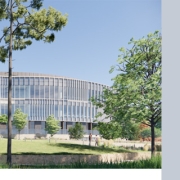The Victorian government’s recent announcement that it’s aiming to build 800,000 new houses in a decade might seem very ambitious, but it aims to address a very serious problem.
Housing supply in Australia has not kept up with demand. There’s a national shortfall of housing, increasing interest rates which are creating significant levels of mortgage stress, spiralling rental prices and the large number of people now priced out of the housing market.
All of these factors are contributing to what’s now being described as a national housing crisis.
But could prefabricated modular construction – which basically involves producing standardised components or the whole of a structure in an off-site factory, then assembling them on-site – become a key part of the solution.
Our team sat down to look at some of the key issues and how prefab might help.
Dr Tharaka Gunawardena: How could prefab help tackle Australia’s housing crisis?
Due to the diminishing availability of skilled labour and the demand for quicker construction, prefab is fast becoming a necessity more than an option.
While providing the means to build houses with speed but with a reduced labour load, prefab can offer many more advantages.
It can allow construction with minimum on-site congestion, waste generation and pollution by moving away from a labour-oriented onsite operation to a more process-oriented offsite manufacturing and assembly process.
The fact that prefab units, especially volumetric modules (where the whole structure including finishes and fittings are manufactured offsite as modules), can be removed from the main structure for future reuse, relocation or repurposing is also a boon. This reusability contributes significantly to prefab buildings having a much lower life cycle energy.
Construction can also start earlier because prefab panels or modules can be manufactured in the factory while the onsite preparation and foundations works get underway.
Financially, investors in housing projects can start generating revenue much earlier and the construction process itself is significantly less vulnerable to adverse weather, which means projects are finished faster.
At the same time, advanced mass customisation methods in design and manufacturing allows architecturally unique housing designs to be built while allowing for mass manufacturing.
In all areas, prefab is a more than capable option in building high-quality dwellings in a short period of time.
Joyce Ferng: Does Australia’s prefab industry have the capacity to match the government’s housing ambitions?
Victoria’s housing goals align well with the PrefabAUS Prefabrication Industry Roadmap for 2023-2033, setting the stage for substantial economic benefits and cost savings associated with Smart Building, which aims to decrease construction time frames and waste while increasing quality, productivity and affordability.
The roadmap projects that Australia could earn an annual benefit of $AU9 billion by 2033, driven by the efficiency of Smart Building practices and prefabrication.
In the short term, prefabrication is a practical solution to meet Victoria’s pressing housing needs. Its ability to provide speedy and cost-efficient housing makes it a strong choice for the demands of both single dwellings and multi-residential buildings.
One piece of analysis points to Melbourne’s potential for 230,000 granny flats, a fast-track solution to housing shortages, thanks to prefabrication and the flexibility it offers in navigating town planning regulations.
This current surge in housing demand is a catalyst for elevating the prefab industry’s capacity and capabilities, from single dwellings to customised complex multi-residential buildings.But there also is the critical need for strategic initiatives and robust partnerships to provide a foundation for this burgeoning industry – providing answers to housing affordability, climate resilience and carbon reduction through energy-efficient design.
Professor Tuan Ngo: Is the current regulatory framework supportive enough to fast track this many houses this fast?
There is an urgent need for more comprehensive standards and guidelines for the design of prefabricated housing.
The importance of a reliable design approach for modular structures cannot be overstated, as an unsuitable design can significantly impact both project costs and timelines.
Currently, traditional ‘limit state design’ criteria, which includes stability, strength and serviceability, are the prevailing design practice for modular buildings. But the absence of comprehensive design guidelines for prefabricated modular buildings can mean these techniques, even when using innovative materials, fall short of expectations.
To ensure a safe and robust design, the design loads (like the dead weight of the structure, the weight of occupants and finishes, and other attachments or fittings) of any structure must take into account all potential circumstances. The design loads in modular construction are different from those in traditional construction because of their unique loading characteristics (owing to the transportation, lifting and handling stages of a prefab installation).
The construction process itself requires distinct infrastructure – demanding careful consideration of factors like geometric inaccuracies and installation procedures.
Offsite construction requires a highly detailed design at the early stages. This means the design requirements for modular buildings are significantly different from those of conventional structures.
But the current design of modular buildings mainly relies on a conventional design system and lacks the necessary design guidelines – so it’s imperative to establish and implement suitable design guidelines for modular prefabricated housing.
Professor Shan Kumar: Is prefab cost effective in the medium to high rise and multi-residential market?
If it’s well coordinated (by engineers, architects and prefab manufacturers), uses appropriate materials (timber, steel, concrete and other sustainable composites) and smartly executed by skilled prefab-modular contractors, then prefab construction will certainly deliver a cost effective, quality home on time.
More of these projects in the pipeline would encourage prefab contractors to invest in research and development, which in turn, would help achieve simple, smarter, innovative modern methods of construction.
To bring more building contractors into this prefab-modular construction space, there must be a mandatory skills requirement.
Government-initiated grants for research and development as well as low interest bank loans and tax credit initiatives for setting up prefab manufacturing factories would help create interest and reduce barriers to entry.
In terms of regulatory requirements, they must be made easy to make this smart construction a viable alternative to building affordable homes – not just in mid to high-rise apartments, but also in single dwellings and unit developments.
Upskilling the prefab-modular industry, which should start at the student undergraduate level, is the key to successfully getting the required number of affordable home projects completed on time.
Professor Priyan Mendis: In terms of research and development, has there been enough investment to allow these kind of rapid solutions for the housing crisis?
There is a genuine need for more investment into the research and development of modern methods of construction, with prefab as the base.
This need is real – both from the construction industry and academia.
The University’s Centre for Advanced Manufacturing of Prefabricated Housing (CAMPH) which, for five years, worked in strong collaboration with industry pioneers continues to disseminate its knowledge and expertise long after its conclusion.
However, many more areas – like advanced and sustainable materials, factory automation, robotics, financing and value chain issues – still need further development.
Unfortunately, recent trends in government funding have seen less and less attention given to research and development in the construction sector.
The urgent need to solve the housing crisis demands a more significant commitment in government funding to ensure that higher quality housing solutions are provided for future Australian homeowners.












